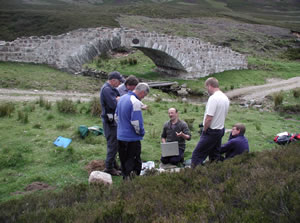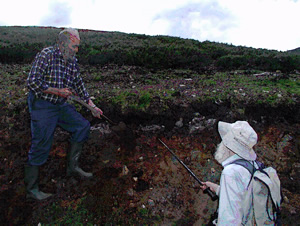 NEMTS RE-ACTIVE
role on the Gleann an t-Slugain Tracks
NEMTS RE-ACTIVE
role on the Gleann an t-Slugain TracksNEMT’s involvement in Hill Tracks continues to have a dual role. The initial 'RE-ACTIVE' role involves participation in what is, or is not happening with regards to the building of new tracks on hill ground and things are certainly very lively on that side at present. The more recently evolved 'PRO-ACTIVE' role concerns our setting up a project that will help address some of the shortcomings of the former. Here is an update on both fronts:
 NEMTS RE-ACTIVE
role on the Gleann an t-Slugain Tracks
NEMTS RE-ACTIVE
role on the Gleann an t-Slugain TracksYou will recall that in our spring edition we were advised that Aberdeenshire Council had refused retrospective planning permission for these tracks. Well, not surprisingly, at the end of July, the estate appealed against the decision. The appeal was to be decided by Ms. Karen Heywood, a Scottish Executive Inquiry Reporter, on the basis of a site visit and written submissions.
The main grounds for the Estate's Appeal and NEMT's position are as follows:-
In addition, the NEMT submitted a reply based on the consequences of damage to the landscape and wild land and this can be viewed on our website. The evidence and arguments, of course, are applicable to many other issues; not just hill tracks.
The next stage in the appeal process was the site visit held on Wednesday 25th October. This was attended by NEMT members who were able to point out particular features but weren't able to argue the merits of the NEMT case.
Almost simultaneously with this edition going to press NEMT received a letter from the Scottish Executive to the effect that the estate's appeal HAD been upheld and that permission was to be granted for the track development. Readers can rest assured NEMT will continue to strive to ensure planning controls on hill tracks are based on technical fact and not political weight or in a short fall in environmental understanding. The case in point is no exception!
The controversy over this track is even more protracted than at Gleann an t-Slugain. To re-cap, since this track involved engineering works without an application for planning permission, Aberdeenshire Council issued an enforcement notice. The estate tenant appealed and the Scottish Executive Reporter upheld the appeal. Dr Adam Watson and two soil-scientists, Sandy Walker and Rodney Heslop, reviewed the Reporters findings and found these to be un-supportable, particularly after they made a site investigation and issued a report on it. The CNPA challenged the Reporters decision on the grounds that the Reporter had not given due weight to the CNPAs view, and CNPA took the case to Judicial Review at the Court of Session. The Court has now upheld the CNPA challenge, and has quashed the Reporters decisions. The matter will now return to the Public Inquiry Reporters Unit for a re-determination. Could there be a better cue for NEMT's planned PRO-ACTIVE ROLE being never more relevant than now!
NEMT held two meetings on King's Road at Corgaff this summer. The former was to learn with Richard Gard, an NEMT Member who we hope will be coordinating the forthcoming work for us, about how well we could use modern IT for our planned project. The latter was on a beautiful June day with Soil Scientist, Sandy Walker, to learn a little more on how not to build hill tracks. As shown in the photograph Sandy advised us on how the role of the 'Iron Pan' is crucial in making or breaking a good hill track. SNH and CNPA were in attendance and there is no doubt everyone felt they had benefited from what Sandy had to teach us. A video and audio recording was made and it hoped to develop these to promulgate the advice and experience that is needed to stall the unnecessary damage that the building of Scotland's hill tracks can, and is causing. Meanwhile our REACTIVE ROLE will continue to ensure that the planning controls for wildland, that are in place, are exercised at least on an equitable basis with the easier-hit village and town dwellers.
The need for this project could not be better illustrated by the foregoing examples. Our efforts to date have made us realise that a good database of existing hill tracks would be a powerful weapon against land agents claiming that tracks have been in existence for a number of years.
This work has the added advantage of working closely with CNPA and SNH who see the value of such a database. It also shows that NEMT will readily work constructively with other bodies and not just criticise them. We have also been advised that core funding will be available from these Agencies during the next financial year.
 |
| Sandy Walker and Dr. Adam Watson identify the 'Iron Pan' |
YEAR ONE - PILOT PROJECT: This is to identify and use a viable technique for collecting high quality information on hilltracks which will complement office-based studies of aerial photographs, etc. NEMT plans to mobilise both our own Members and basically anyone who is interested (Cairngorms Campaign has already pledged their support) to help us as part of their usual hill-walking activities. Folk will be invited to carry their own GPS (handheld Global Positioning System phone-style gadget) and a digital camera and send in the co-ordinates of whatever track, new or old, they are walking on plus a digital photograph showing the condition of that track. Richard Gard will provide technical support and we will begin to build up an up to date record of what is happening and this can be superimposed on the existing records. The area for the initial project has still to be defined.
Very importantly CNPA and SNH will assist in ensuring that we are building on, and not duplicating, any work that has already been done in this respect. This backdrop will also mean that our work will be channelled into the mainstream conservation movement in Scotland (and beyond.)
YEAR TWO FULL PARK MAPPING: Following this pilot project, we plan to draw up a proposal for external funding to map the existing hill tracks in the CNP
So, stand-by Members and Non-Members alike, your help is shortly going to be needed to marry the new technology now at our disposal with the wisdom of the soil scientists and the backing of the lead agencies. We will use our website and direct postings to keep you up to date with developments. This is a time for constructive action - and it is out in the field, thank heavens!
Jennifer Cook and Dave Windle
Please let the webmaster know if there are problems with viewing these pages or with the links they contain.